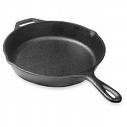
| Before you begin using a new or refurbished cast iron skillet, however, it must be prepared for use through a process called seasoning. Seasoning a cast iron skillet is not especially difficult, but it does need to done right and often to maintain the natural non-stick qualities of the pan. If you’ve ever seen a cast iron skillet up close, you may have noticed a black layer on the cooking surface. That charred or burnt appearance is one sign of a well-seasoned cast iron skillet. Here’s how you can season a cast iron skillet at home: |
| Remove all packaging and adhesives from a new unseasoned cast iron skillet. Some modern cast iron cookware is preseasoned at the factory, but it won’t hurt to season it again. Make sure all paper and pricing stickers are completely removed. Use a sponge and light, soapy water to quickly remove any remaining surface dirt and dry the pan thoroughly with paper towels or by air drying. This is the only time water should ever be used to clean the inside of a cast iron skillet. Future cleaning should be done with dry paper towels and salt only, to prevent damage from rust. Once the cast iron pan is completely dry, find a supply of cooking oil, shortening, bacon grease or animal lard. Preheat the oven and prepare the skillet. Different people will tell you different temperatures for proper seasoning, ranging from 250 to 500 degrees Fahrenheit. Since the main point of seasoning is to bake the oil or grease into the pores of the skillet, a preheating temperature of 350 degrees or higher seems reasonable. As the oven heats, wipe a generous amount of your chosen oil or grease around the inside of the skillet. Wipe out any obvious excesses, but remain generous with the coating. Place the cast iron skillet upside down on the top rack of the hot oven. To prevent the grease or oil from dripping onto the bottom burners, place a cookie sheet or other oven-proof tray on the lowest rack. Allow the pan to remain in the oven for at least an hour. Do not be alarmed if you see or smell smoke — this is a normal part of the seasoning process. The oil or grease is filling up all of the pores of the cast iron, creating fewer crevices for food to become trapped. After an hour or more has elapsed, use oven mitts to remove the cast iron skillet from the oven. Place on a heat-resistant surface (right side up) and allow the skillet to cool. The cast iron skillet is now seasoned, but some foods such as eggs may still stick to the bottom without additional oils or grease. The seasoning process needs to be repeated several times before a sufficient layer of charring has built up in the bottom of the pan. Ideally, a cast iron skillet should be wiped out completely after cooking, and then put through the seasoning process again. It may take several years for a cast iron skillet to reach the non-stick level of your Grandmother’s prized frying pan, but the results should be worth the effort. |










